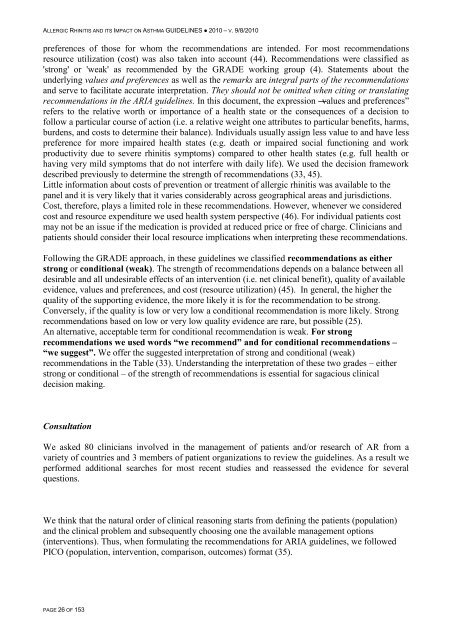Allergic Rhinitis and its Impact on Asthma - ARIA
Allergic Rhinitis and its Impact on Asthma - ARIA
Allergic Rhinitis and its Impact on Asthma - ARIA
You also want an ePaper? Increase the reach of your titles
YUMPU automatically turns print PDFs into web optimized ePapers that Google loves.
ALLERGIC RHINITIS AND ITS IMPACT ON ASTHMA GUIDELINES ● 2010 – V. 9/8/2010<br />
preferences of those for whom the recommendati<strong>on</strong>s are intended. For most recommendati<strong>on</strong>s<br />
resource utilizati<strong>on</strong> (cost) was also taken into account (44). Recommendati<strong>on</strong>s were classified as<br />
'str<strong>on</strong>g' or 'weak' as recommended by the GRADE working group (4). Statements about the<br />
underlying values <str<strong>on</strong>g>and</str<strong>on</strong>g> preferences as well as the remarks are integral parts of the recommendati<strong>on</strong>s<br />
<str<strong>on</strong>g>and</str<strong>on</strong>g> serve to facilitate accurate interpretati<strong>on</strong>. They should not be omitted when citing or translating<br />
recommendati<strong>on</strong>s in the <strong>ARIA</strong> guidelines. In this document, the expressi<strong>on</strong> ―values <str<strong>on</strong>g>and</str<strong>on</strong>g> preferences‖<br />
refers to the relative worth or importance of a health state or the c<strong>on</strong>sequences of a decisi<strong>on</strong> to<br />
follow a particular course of acti<strong>on</strong> (i.e. a relative weight <strong>on</strong>e attributes to particular benef<str<strong>on</strong>g>its</str<strong>on</strong>g>, harms,<br />
burdens, <str<strong>on</strong>g>and</str<strong>on</strong>g> costs to determine their balance). Individuals usually assign less value to <str<strong>on</strong>g>and</str<strong>on</strong>g> have less<br />
preference for more impaired health states (e.g. death or impaired social functi<strong>on</strong>ing <str<strong>on</strong>g>and</str<strong>on</strong>g> work<br />
productivity due to severe rhinitis symptoms) compared to other health states (e.g. full health or<br />
having very mild symptoms that do not interfere with daily life). We used the decisi<strong>on</strong> framework<br />
described previously to determine the strength of recommendati<strong>on</strong>s (33, 45).<br />
Little informati<strong>on</strong> about costs of preventi<strong>on</strong> or treatment of allergic rhinitis was available to the<br />
panel <str<strong>on</strong>g>and</str<strong>on</strong>g> it is very likely that it varies c<strong>on</strong>siderably across geographical areas <str<strong>on</strong>g>and</str<strong>on</strong>g> jurisdicti<strong>on</strong>s.<br />
Cost, therefore, plays a limited role in these recommendati<strong>on</strong>s. However, whenever we c<strong>on</strong>sidered<br />
cost <str<strong>on</strong>g>and</str<strong>on</strong>g> resource expenditure we used health system perspective (46). For individual patients cost<br />
may not be an issue if the medicati<strong>on</strong> is provided at reduced price or free of charge. Clinicians <str<strong>on</strong>g>and</str<strong>on</strong>g><br />
patients should c<strong>on</strong>sider their local resource implicati<strong>on</strong>s when interpreting these recommendati<strong>on</strong>s.<br />
Following the GRADE approach, in these guidelines we classified recommendati<strong>on</strong>s as either<br />
str<strong>on</strong>g or c<strong>on</strong>diti<strong>on</strong>al (weak). The strength of recommendati<strong>on</strong>s depends <strong>on</strong> a balance between all<br />
desirable <str<strong>on</strong>g>and</str<strong>on</strong>g> all undesirable effects of an interventi<strong>on</strong> (i.e. net clinical benefit), quality of available<br />
evidence, values <str<strong>on</strong>g>and</str<strong>on</strong>g> preferences, <str<strong>on</strong>g>and</str<strong>on</strong>g> cost (resource utilizati<strong>on</strong>) (45). In general, the higher the<br />
quality of the supporting evidence, the more likely it is for the recommendati<strong>on</strong> to be str<strong>on</strong>g.<br />
C<strong>on</strong>versely, if the quality is low or very low a c<strong>on</strong>diti<strong>on</strong>al recommendati<strong>on</strong> is more likely. Str<strong>on</strong>g<br />
recommendati<strong>on</strong>s based <strong>on</strong> low or very low quality evidence are rare, but possible (25).<br />
An alternative, acceptable term for c<strong>on</strong>diti<strong>on</strong>al recommendati<strong>on</strong> is weak. For str<strong>on</strong>g<br />
recommendati<strong>on</strong>s we used words “we recommend” <str<strong>on</strong>g>and</str<strong>on</strong>g> for c<strong>on</strong>diti<strong>on</strong>al recommendati<strong>on</strong>s –<br />
“we suggest”. We offer the suggested interpretati<strong>on</strong> of str<strong>on</strong>g <str<strong>on</strong>g>and</str<strong>on</strong>g> c<strong>on</strong>diti<strong>on</strong>al (weak)<br />
recommendati<strong>on</strong>s in the Table (33). Underst<str<strong>on</strong>g>and</str<strong>on</strong>g>ing the interpretati<strong>on</strong> of these two grades – either<br />
str<strong>on</strong>g or c<strong>on</strong>diti<strong>on</strong>al – of the strength of recommendati<strong>on</strong>s is essential for sagacious clinical<br />
decisi<strong>on</strong> making.<br />
C<strong>on</strong>sultati<strong>on</strong><br />
We asked 80 clinicians involved in the management of patients <str<strong>on</strong>g>and</str<strong>on</strong>g>/or research of AR from a<br />
variety of countries <str<strong>on</strong>g>and</str<strong>on</strong>g> 3 members of patient organizati<strong>on</strong>s to review the guidelines. As a result we<br />
performed additi<strong>on</strong>al searches for most recent studies <str<strong>on</strong>g>and</str<strong>on</strong>g> reassessed the evidence for several<br />
questi<strong>on</strong>s.<br />
We think that the natural order of clinical reas<strong>on</strong>ing starts from defining the patients (populati<strong>on</strong>)<br />
<str<strong>on</strong>g>and</str<strong>on</strong>g> the clinical problem <str<strong>on</strong>g>and</str<strong>on</strong>g> subsequently choosing <strong>on</strong>e the available management opti<strong>on</strong>s<br />
(interventi<strong>on</strong>s). Thus, when formulating the recommendati<strong>on</strong>s for <strong>ARIA</strong> guidelines, we followed<br />
PICO (populati<strong>on</strong>, interventi<strong>on</strong>, comparis<strong>on</strong>, outcomes) format (35).<br />
PAGE 26 OF 153


